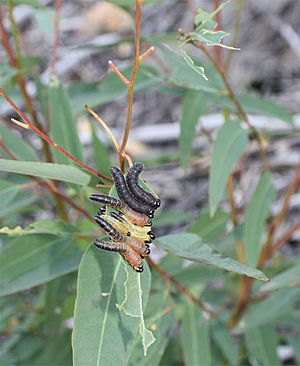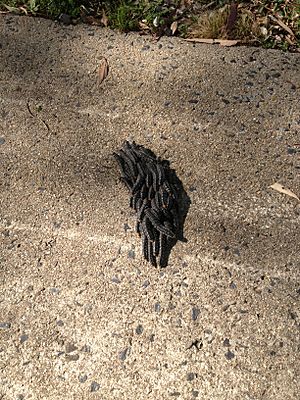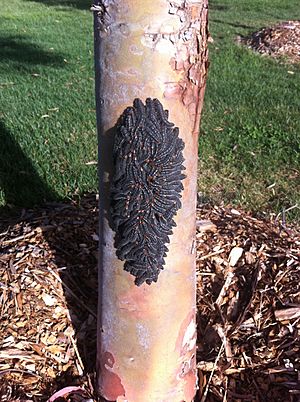Spitfire sawfly facts for kids
Quick facts for kids Spitfire sawfly |
|
|---|---|
| Scientific classification |
The spitfire sawfly (Perga affinis) is an insect found in Australia. It belongs to a group of insects called hymenoptera, which also includes bees and wasps. This sawfly can grow up to 22 millimeters (about 1 inch) long. It has two pairs of wings that can spread up to 40 millimeters wide. These wings are a lovely honey color.
The young sawflies, called larvae, look a bit like caterpillars. They can grow up to 80 millimeters (about 3 inches) long. The sawfly gets its name from the female's special saw-like tool, called an ovipositor. She uses this tool to cut small holes in plants where she lays her eggs. Even though sawflies are related to wasps, they do not have a narrow waist or a sting like wasps do.
You might not often see the adult sawflies. However, their larvae are quite easy to spot as they get bigger. These larvae look like hairy caterpillars. You can usually find them during the day in groups on the branches and stems of Eucalyptus trees. At night, they spread out to eat the leaves of their host plant.
If a spitfire sawfly larva feels threatened, it will lift its head. Then, it squirts out a strong-smelling, yellow-green liquid. This liquid is mostly made of eucalyptus oil. It helps to scare away animals that might want to eat them. This action is why they are called 'spitfires'!
Contents
What Do Spitfire Sawflies Look Like?
Spitfire sawfly larvae can be dark blue, black, yellow, or brown. Their color depends on the specific type of sawfly. They can grow up to 80 millimeters long. Their bodies have a few white, bristly hairs. The tail of the larva is yellow. When they are bothered, they raise their tail. They can also release a smelly liquid from their tail.
During the day, these larvae gather in groups of 20 or 30. This helps them stay safe from predators. At night, they spread out to find food. Adult sawflies are mostly black or brown. They have yellowish marks and are about 25 millimeters long.
Life Cycle of the Spitfire Sawfly
Adult sawflies are usually seen from January to May, especially in autumn. The female sawfly uses her saw-like ovipositor to lay eggs under the surface of a leaf. The larvae are most active during late winter and spring.
Around mid-spring, the larvae go into the soil to pupate. This means they change into a pupa, which is a resting stage. They build strong, paper-like cocoons in the soil. These cocoons are often found clustered together, a few centimeters deep. The pupa can stay in its cocoon for two or three years. After this time, the adult sawfly finally comes out.
How Spitfire Sawflies Affect Trees
Spitfire sawfly larvae eat the leaves of young trees and new branches. They can sometimes strip the leaves from branches, especially at the top of the tree. Usually, the tree grows new leaves during the spring and summer.
If trees are attacked many times, their growth might slow down a lot. However, it is rare for a tree to die from these attacks. In Western Australia, the Wandoo tree is the one most often affected by spitfire sawflies.
Controlling Spitfire Sawflies
If you can reach the groups of larvae, the easiest way to control them is to remove and destroy them during the day. There are also tiny wasps that act as parasites. These wasps help to keep the sawfly population in check. Because of this, widespread damage from spitfire sawflies is not common.




